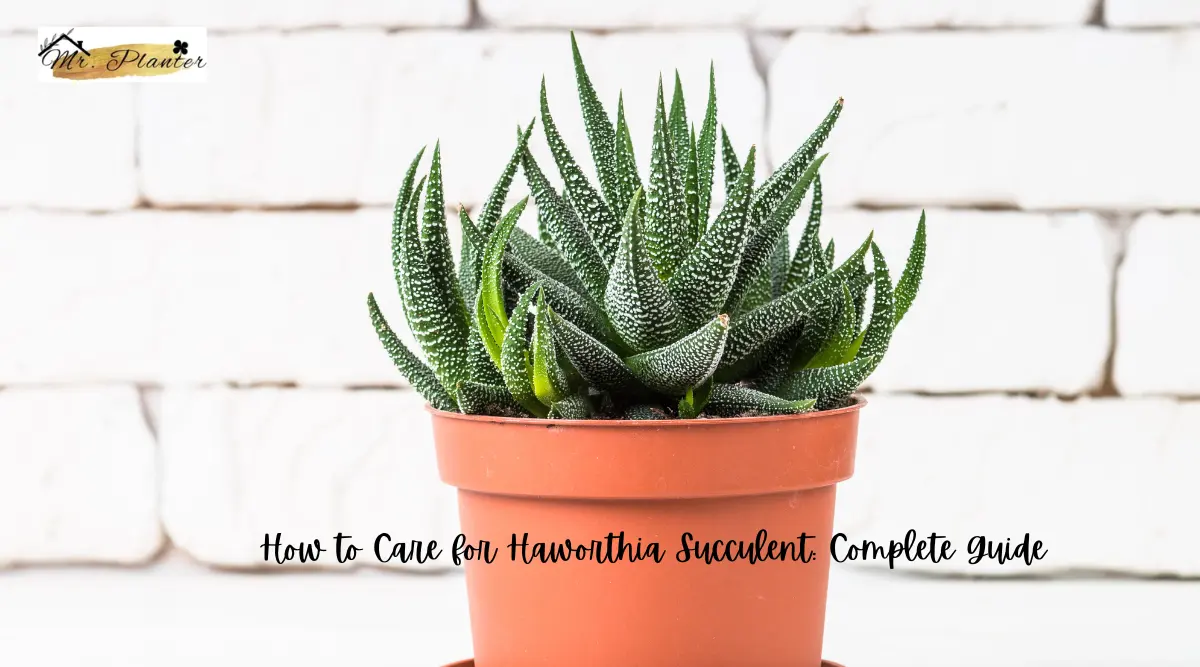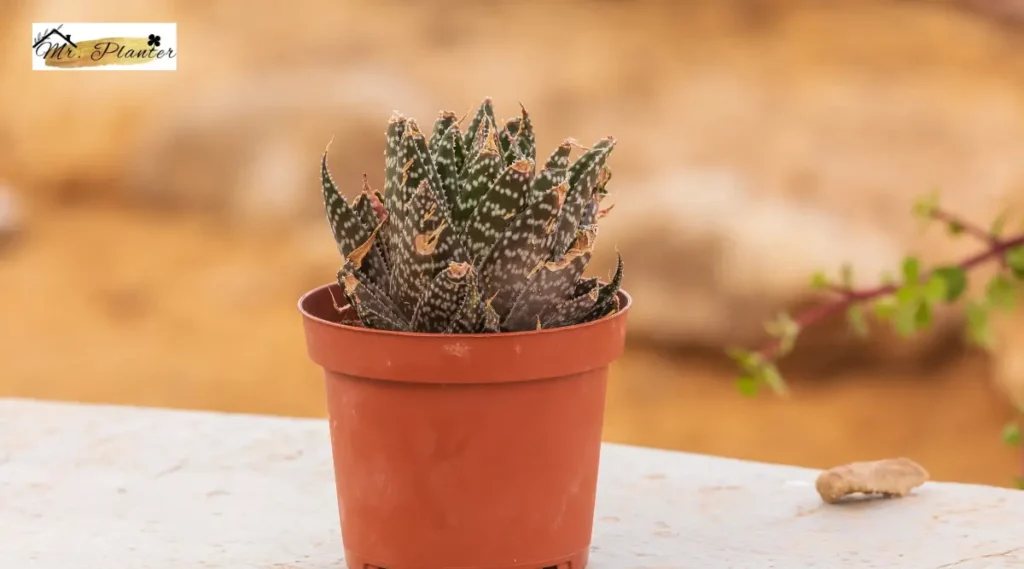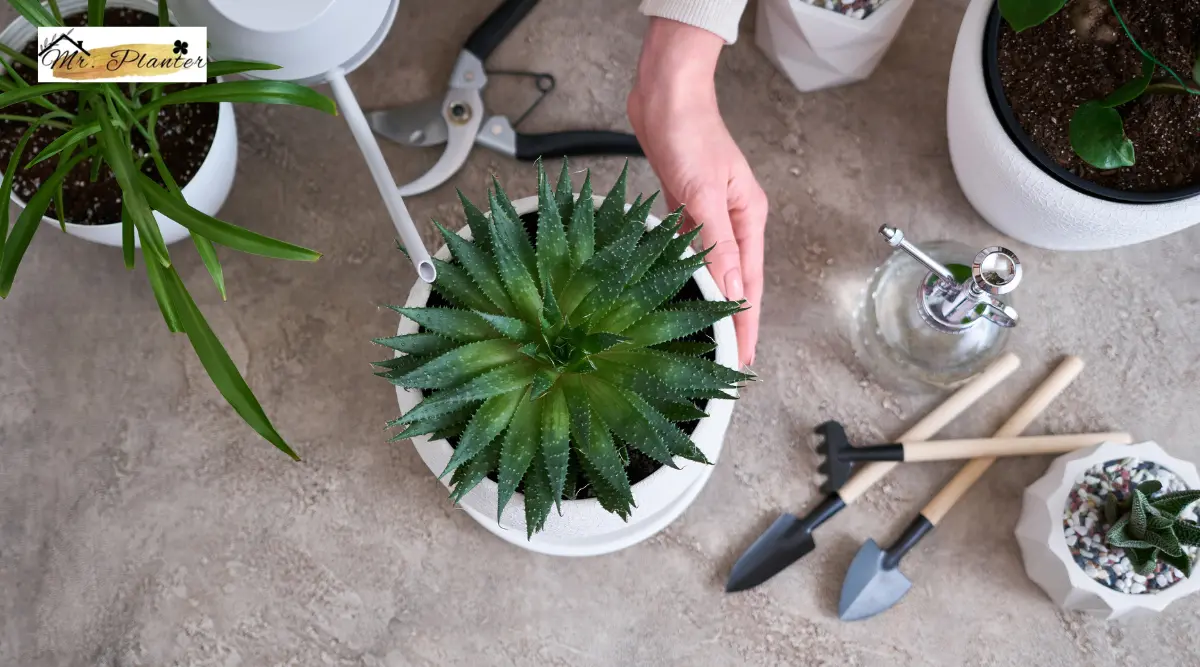Looking to care for Haworthia succulents?
These low-maintenance South African natives, also known as zebra cactus or pearl plant, have a unique architectural look.
To ensure your Haworthia thrives, they need bright light but not direct sun, with temperatures between 70-95°F. Remember, sparingly water them and let the soil dry completely between watering to avoid root rot.
In this guide, we’ll keep your Haworthia healthy and happy.

Key Takeaways
- Haworthia is a low-maintenance houseplant that’s easy to care for.
- These slow-growing plants require bright light but not all-day full sun and should be watered sparingly.
- Common problems for Haworthia include root rot and mealybugs, but these can be avoided with proper care.
Understanding Haworthia
If you’re in search of an easy-to-care-for, eye-catching succulent, look no further than Haworthia.
These delightful plants hail from South Africa and belong to the Asphodelaceae family, which also counts Aloe among its members.
Haworthias are frequently dubbed “zebra cactus” or “zebra plants” due to their striking stripes.
Diverse Species: There are over 70 distinct species of Haworthia, not to mention a multitude of cultivars.
Popular Choices: Some of the most favored species include Haworthia limifolia, Haworthia cooperi, Haworthia fasciata, and Haworthia truncate.
Varied Appearance: These plants come in various shapes and sizes, from petite rosettes to more extensive clumps.
Unique Leaves: Haworthias are known for their thick, fleshy leaves, which are often arranged in rosette patterns. Leaf textures can range from smooth to bumpy or ridged, depending on the species.
Colorful Palette: Their colors span from vivid green to deep brown, with certain species boasting translucent windows on their leaves, enabling light to penetrate into the plant’s core.
Easy Care: What sets Haworthias apart is their low-maintenance nature. They thrive in bright, indirect light and well-draining soil.
These succulents are resilient against drought and can endure extended periods without water, though it’s vital not to let them desiccate entirely.
When watering, it’s advisable to water deeply and then let the soil thoroughly dry before the next watering.
Slow Growth: Haworthias are gradual growers and seldom need repotting. You can propagate them through division or leaf cuttings, and new plants frequently sprout at the base of the parent plant.
So, Haworthia succulents are a superb choice for those seeking an appealing, undemanding plant.
With their distinct appearance and straightforward care requirements, they make an excellent addition to any collection.
Haworthia Light Requirements
Haworthias prefer partial shade, but they can tolerate some sun exposure. In areas with hot afternoon sun, it’s best to provide them with some shade to prevent sunburn.

Hardiness Zones
Haworthias are typically grown as indoor plants, but they can be grown outdoors in hardiness zones 9 to 11.
In cooler climates, they can be grown in containers and brought indoors during the winter.
Location
When selecting a location for your Haworthia, choose a spot that provides bright light and protection from direct sunlight.
It’s also important to choose a location with good air circulation to prevent fungal diseases.
Overall, providing your Haworthia with the right growing conditions is essential for its health and longevity. With proper care, your Haworthia will thrive and add beauty to your home or garden.
Haworthia Watering Requirements
Haworthia succulents are drought-tolerant plants that prefer to be on the dry side. Overwatering can lead to root rot and other problems. It is essential to allow the soil to dry out between waterings.

The frequency of watering depends on various factors such as the size of the pot, the type of soil, and the humidity level.
In general, water your Haworthia every two to three weeks in direct light, allowing the soil to dry out between waterings. Expect to water more often in brighter light and less often in lower light.
When watering, make sure to water the soil and not the leaves. Avoid getting water on the leaves as it can lead to rot and other problems.
Also, make sure to use a well-draining soil mix that allows excess water to drain away quickly.
Haworthia Fertilizer Requirements
Haworthia succulents do not require frequent fertilization, but they do need some nutrients to thrive.
Use a cactus fertilizer or a balanced fertilizer diluted to half strength once a month during the growing season (spring and summer).
Do not fertilize during the winter months when the plant is dormant.
When applying fertilizer, make sure to follow the instructions on the label and avoid overfertilizing. Overfertilizing can lead to root burn and other problems.
Also, make sure to water the plant thoroughly after fertilizing to avoid salt buildup in the soil.
Haworthia Soil Requirements
Haworthias require well-draining soil, as they are susceptible to root rot. It’s best to plant them in sandy, well-draining, neutral soil.
You can mix in some perlite or pumice to improve drainage. Avoid using heavy soils or those that retain too much moisture.
Haworthia Temperature Requirements
Haworthias prefer average to warm temperatures, between 65°F and 80°F (18°C to 27°C).
They can tolerate cooler temperatures, but not below 50°F (10°C). It’s important to protect them from frost and extreme heat.
Haworthia Humidity Requirements
Haworthias are adapted to lower humidity levels, so they don’t require high humidity. Average home humidity levels are usually sufficient for their needs.
Haworthia Propagation Techniques
If you want to expand your collection of Haworthia succulents, propagation is a great way to do it.
There are several propagation techniques you can use, including offsets, leaf cuttings, and seeds.
Propagation By Offsets
Propagating Haworthia through offsets is the easiest and most common method. Offsets are small plants that grow from the base of the mother plant. To propagate using offsets, use a sharp knife to cut the offset from the mother plant.
Be careful not to damage the roots. Once you have removed the offset, let it dry for a day or two before planting it in well-draining soil. Make sure to water it sparingly until it establishes roots.
Propagation By Leaf Cuttings
Propagating Haworthia through leaf cuttings is another popular method. To do this, select a healthy leaf from the parent plant and remove it with a sharp, clean knife.
Let the leaf dry for a few days until a callus forms over the cut end. Once the callus has formed, plant the leaf in well-draining soil. Water it sparingly until it establishes roots.
Propagation By Seeds
Propagating Haworthia from seeds is the most challenging method. However, it is the only way to create new hybrids.
To propagate using seeds, sow them in well-draining soil and keep them moist until they germinate. Once the seedlings have established roots, transplant them into individual containers.
Regardless of the propagation method you choose, make sure to fertilize the new plants sparingly.
Over-fertilizing can damage the roots and stunt growth. Also, avoid exposing the new plants to direct sunlight until they have established roots.
Overall, Haworthia propagation is an easy and rewarding process that allows you to expand your collection of these beautiful succulents.
Haworthia Repotting
When repotting your Haworthia, choose a pot that is only slightly larger than the current one.
Haworthias prefer shallow pots, so make sure the new pot is not too deep. The new pot should also have ample drainage holes to ensure proper drainage.

Frequency:
Haworthias should be repotted every 2-3 years, or when the plant has outgrown its current container.
The process to Repot:
To repot your Haworthia, gently remove it from its current pot and shake off any excess soil. Inspect the roots and remove any dead or rotting ones.
Fill the new pot with fresh, well-draining soil, and place the Haworthia in the center.
Add more soil around the edges, gently pressing it down to secure the plant in place. Water the plant lightly and allow the soil to settle before watering again.
Transplanting Your Haworthia
Transplanting your Haworthia is similar to repotting, but it involves moving the plant to a different location. You may need to transplant your Haworthia if it is not getting enough light or if it is overcrowded in its current location.
Frequency:
Transplanting should only be done when necessary, such as when the plant is not thriving in its current location.
Transplanting process:
To transplant your Haworthia, follow the same steps as repotting. However, instead of placing the plant in a new pot, choose a new location with the appropriate lighting and soil conditions.
Make sure to plant the Haworthia at the same depth as it was in its previous location.
Haworthia Common Problems and Solutions
Even though Haworthia succulents are relatively easy to care for, they can still encounter some common problems.
Here are some of the most common issues and their solutions:
Root Rot
Root rot is a common problem with Haworthia succulents. It is caused by overwatering and can lead to the plant’s death. Signs of root rot include yellowing leaves, mushy and soft roots, and a foul smell.
To prevent root rot, make sure the soil is well-draining and only water the plant when the soil is completely dry. If you suspect root rot, remove the plant from the soil, cut off any affected roots, and repot it in fresh, well-draining soil.
Haworthia Pest Infestation
Haworthia succulents can be attacked by pests such as mealybugs, spider mites, and scale insects.
These pests can cause damage to the leaves and stems of the plant, and can even lead to its death.
To prevent pests, keep the plant in a clean and well-ventilated area, and inspect it regularly for any signs of infestation.
Remove any pests by hand or use an insecticidal soap if you notice them.
Yellow Leaves
Yellow leaves are a common problem with Haworthia succulents. This can be caused by overwatering, underwatering, or exposure to extreme temperatures.
To prevent yellow leaves, make sure Hawowthia is not overwatered or underwatered, and keep it in a location with moderate temperatures.
Leaves Curling
Leaves curling is another common problem with Haworthia succulents. This can be caused by underwatering, overwatering, or exposure to extreme temperatures.
To prevent leaves from curling, make sure the plant is watered properly, and keep it in a location with moderate temperatures.
White Spots
White spots on the leaves of a Haworthia succulent can be a sign of fungal or bacterial infection.
To prevent white spots, make sure the plant is in a clean and well-ventilated area, and avoid getting water on the leaves. If you notice any white spots, remove the affected leaves and treat the plant with a fungicide.
Haworthia Care FAQs
What is the best soil type for Haworthia succulents?
Haworthia succulents need well-draining soil to prevent root rot. A mixture of sand, perlite, and peat moss can provide the necessary drainage. The soil should be slightly acidic with a pH between 6.0 and 7.0. Avoid using heavy soils that retain moisture, such as garden soil or potting soil.
How often should I water my Haworthia succulent?
Haworthia succulents are drought-tolerant and prefer to be kept on the drier side. Water your plant only when the soil is completely dry. Overwatering can lead to root rot and other issues. During the winter months, when the plant is dormant, reduce watering frequency.
What are some common types of Haworthia succulents?
There are many different types of Haworthia succulents, each with its own unique characteristics. Some of the most common types include Haworthia fasciata, Haworthia attenuata, and Haworthia cooperi. Each of these types has different leaf shapes, colors, and patterns.
How do I propagate Haworthia succulents?
Haworthia succulents can be propagated by division or leaf cuttings. To propagate by division, gently remove the plant from its pot and separate the offsets from the mother plant. Plant the offsets in a separate pot with well-draining soil. To propagate by leaf cuttings, gently remove a leaf from the mother plant and let it dry out for a day or two. Plant the leaf in well-draining soil and water sparingly until new growth appears.
What are some common issues that can affect the health of Haworthia succulents?
Overwatering is one of the most common issues that can affect the health of Haworthia succulents. Root rot can occur if the soil is too wet for too long. Other issues include pests such as mealybugs and spider mites, as well as fungal infections. Make sure to provide your plant with proper care and maintenance to prevent these issues.
Where is the best place to keep my Haworthia succulent?
Haworthia succulents prefer bright, indirect light. They can also tolerate some direct sunlight, but too much can cause leaf burn. Keep your plant in a warm room with temperatures ranging from 75 to 90 °F (24 to 32 °C). Avoid placing your plant in a drafty area or near air conditioning or heating vents.

